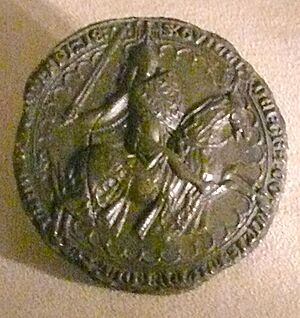William I, Count of Hainaut facts for kids
Quick facts for kids
William the Good
|
|
|---|---|
| Count of Hainaut, Holland, and Zeeland | |

16th-century depiction
|
|
| Born | c. 1286 |
| Died | 7 June 1337 Valenciennes |
| Noble family | House of Wittelsbach |
| Spouse(s) | Joan of Valois |
| Issue | William II, Count of Hainaut Margaret II, Countess of Hainaut Philippa, Queen of England Joanna, Duchess of Jülich Isabella of Hainaut |
| Father | John II, Count of Hainaut |
| Mother | Philippa of Luxembourg |
William the Good (also known as Dutch: Willem or French: Guillaume) was an important ruler in Europe. He was born around 1286 and passed away on June 7, 1337. William was a powerful count, which was like being a regional ruler. He governed several areas: Hainaut (as William I), Holland (as William III), and Zeeland (as William II). He held these titles from 1304 until his death.
Contents
Becoming a Count
William was born around 1286. His father was John II, Count of Hainaut, and his mother was Philippa of Luxembourg. He also had a brother named John of Beaumont and a sister named Alice of Hainault.
At first, William was not expected to become a count. He had two older brothers. Sadly, both of them passed away. His brother John was killed in a battle in 1302. His other brother, Henry, died in 1303. After their deaths, William became the next in line to inherit his father's lands and titles. This made him the heir apparent.
William's Rule and Wars
Before he became count, William faced a tough battle. In 1304, he was defeated by Guy of Namur on an island called Duiveland. Guy and Duke John II of Brabant then took control of much of Zeeland and Holland.
However, things changed when William officially became the new count later that same year. He quickly managed to get back the territories that had been lost.
Ending the War with Flanders
William continued a long war against Flanders. This conflict finally ended with the Peace of Paris in 1323. In this treaty, the Count of Flanders gave up all his claims to Zeeland. In return, William gained full control of Zeeland. He also agreed to give up any claims he had on Imperial Flanders.
Expanding His Lands
William was very active in expanding his influence. He took over most of the Bishopric of Utrecht. He also tried to conquer Friesland, but he was stopped by a local leader named Hessel Martena.
When his uncle, Guy d'Avesnes, who was the Bishop of Utrecht, died, William took over his land in Amsterdam. He then added Amsterdam to his territory of Holland.
Important Marriages and Alliances
William was very smart about making alliances. He arranged for many of his daughters to marry important rulers across Europe. For example, King Edward III of England married his daughter Philippa of Hainault. The Holy Roman Emperor Louis IV married another of his daughters, Margaret II, Countess of Hainault.
William himself was married to Joan of Valois, who was the sister of the future King Philip VI of France. These important marriages gave William a lot of influence and respect. He used this power to help his own counties grow and become stronger.
William's Family
On May 19, 1305, William married Joan of Valois. She was the sister of the future King Philip VI of France. Together, they had several children:
- William II, Count of Hainaut (1307–1345)
- John (died 1316)
- Margaret II, Countess of Hainault (1311–1356), who married Louis IV, Holy Roman Emperor
- Philippa of Hainault (around 1313–1369), who married King Edward III of England
- Agnes (died 1327)
- Joanna of Hainaut (1315–1374), who married William V, Duke of Jülich
- Isabelle of Hainaut (1323–1361), who married Robert of Namur
- Louis (1325–1328)
- Jan Aelman (1320–1389), who was an illegitimate son and a knight.
See also
- Counts of Hainaut family tree
- Counts of Holland family tree


